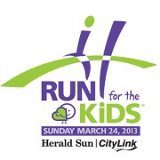PUBLISHED ON 28/03/2013 ON STUDENT VIEW
Annual Run for the Kids continuining to raise much needed funds for the Royal Children”s Hospital:
The Royal Children’s Hospital is a vital part that helps so many children and their families each year. Each participant plays a part in benefitting those children at the Royal Children’s Hospital who aren’t able to run, walk or skip their way around the course. The money raised will fund projects, research and technological innovations to ensure that every child receives the very best treatment now and into the future.
There were two course options for participants to choose from;
Participants raised an amazing $1.95 million yesterday until CityLink then added $50,000 taking the total to an astonishing $2 million.
Tony Abbott was amongst the sea of participants yesterday, finishing the 15 km super course in 1 hour 32 minutes and 43 seconds. Even Australian political figures are getting involved in bettering the lives of young sick Australians.
The event partners included Herald Sun and CityLink, both aim to promote and raise awareness for the event. Since 1931 when the Good Friday Appeal began, employees got together with sport’s officials to run a sports carnival that raised money for the hospital, that was then struggling in the midst of the Great Depression.
Corporate sponsors of the event included Nike, Mazda, 7 News, Mix101.1 Radio, City of Melbourne and the Victorian Police. Nike offered participants free training sessions with Nike+ Run Club, holding sessions four times a week. The training sessions were held on a Monday, Wednesday, Thursday and Saturdays starting on Wednesday 30th of January for an eight week program. The sessions covered different distances in each session to get participants ready for the race. There was no need for participants to register; they just needed to turn up on the day.
The top fundraiser for this year’s Run for the Kids was Katia Fowler raising, $7,775.00. Many people raised so much money, even a single dollar can help. If every person in Australia donated a single dollar, then they would be able to raise $22 million, an impact which will change the hospital’s ability in treating the sick children. A single dollar, which would not affect anyone that much, can potentially aim to save a child’s life.
By participating in either the run or donating money you can help so much. Every small effort will make a difference to these children’s life. So next friday in the Good Friday, everyone dig deep, let’s raise as much money as we can and help the patients who are young children and cannot help themselves! I’m sure you don’t need that extra coffee tomorrow morning on your way to work! 🙂
Related articles
- Vic appeal raises $16.4m for kids (bigpondnews.com)
- Donate to the Royal Children’s Hospital Good Friday Appeal (3aw.com.au)
- Hospital Wards Honoured as New Development Street Names (taylorwimpey.co.uk)
- The People’s Voice – Newman breaks pledge to keep royal children’s hospital (workersbushtelegraph.com.au)
- Children’s Miracle Network Hospitals Tops $300 Million in 2012 Funds Raised, Sets New Records on Path to Billion Dollar Goal (prweb.com)
